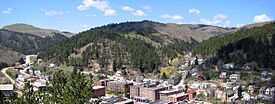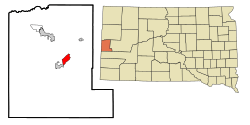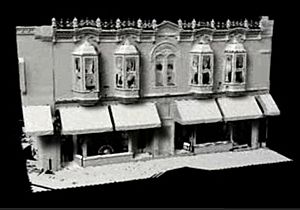Deadwood, South Dakota facts for kids
Quick facts for kids
Deadwood, South Dakota
Owáyasuta
|
|
|---|---|

Modern Deadwood viewed from Mount Moriah
|
|

Location in Lawrence County and the state of South Dakota
|
|
| Country | United States |
| State | South Dakota |
| County | Lawrence |
| Founded | April 1876 |
| Incorporated | February 22, 1881 |
| Government | |
| • Type | City Commission |
| Area | |
| • Total | 4.929 sq mi (12.767 km2) |
| • Land | 4.929 sq mi (12.767 km2) |
| • Water | 0.000 sq mi (0.000 km2) |
| Elevation | 4,715 ft (1,437 m) |
| Population
(2020)
|
|
| • Total | 1,156 |
| • Estimate
(2023)
|
1,343 |
| • Density | 272.0/sq mi (105.2/km2) |
| Time zone | UTC–7 (Mountain (MST)) |
| • Summer (DST) | UTC–6 (MDT) |
| ZIP Code |
57732
|
| Area code(s) | 605 |
| FIPS code | 46-15700 |
| GNIS feature ID | 1267350 |
| Sales tax | 6.2% |
|
Deadwood Historic District
|
|
| Architectural style | Neoclassical, Late Victorian |
| NRHP reference No. | 66000716 |
| Added to NRHP | October 15, 1966 |
Deadwood is a city in South Dakota, United States. It is the main town of Lawrence County. Early settlers named it after the many dead trees found in its valley. The city was very busy from 1876 to 1879. This was after gold was found there, starting the Black Hills Gold Rush.
At its busiest, Deadwood had about 25,000 people. Many famous figures from the Old West visited, like Wyatt Earp, Calamity Jane, Seth Bullock, and Wild Bill Hickok. Wild Bill Hickok was killed in Deadwood.
The whole town is a special National Historic Landmark District. This means its old buildings from the Gold Rush time are well-protected. Deadwood has five history museums run by a group called Deadwood History, Inc. Deadwood is close to Lead, so the two towns are often called "Lead-Deadwood" together.
In 2020, 1,156 people lived in Deadwood. By 2023, it was estimated to have 1,343 people.
Contents
History of Deadwood
The 1800s: Gold Rush and Growth
Deadwood started illegally in the 1870s. The land was given to American Indians by the 1868 Treaty of Laramie. This treaty said the Black Hills belonged to the Lakota people. But in 1874, Colonel George Armstrong Custer found gold in the Black Hills.
This discovery started the Black Hills Gold Rush. Soon, Deadwood became a new, wild town. Its population quickly grew to about 5,000 people.
A famous saloon called the Gem Variety Theater opened in 1877. It was run by Al Swearengen. The saloon burned down in 1879 and was rebuilt. It burned down again in 1899, and Swearengen left town. Deadwood was known for being a lawless place. Murders were common, and justice was not always fair.
The town became even more famous when the gunman Wild Bill Hickok was killed there. Mount Moriah Cemetery is where Hickok, Calamity Jane, and Seth Bullock are buried. Hickok's killer, Jack McCall, was tried twice. This happened because Deadwood was an illegal town in Indian Territory. So, its first trial was not considered valid. McCall was found guilty and hanged in a different court.
As gold mining changed from simple panning to deep mining, Deadwood became a more settled town. In 1876, a smallpox sickness spread. Many people got sick, and tents were set up to keep them separate. Also in 1876, General George Crook chased the Sioux Indians after the Battle of the Little Bighorn. This chase ended in Deadwood and is called the Horsemeat March.
The Homestake Mine in nearby Lead started in 1877. For many years, it was the longest-running gold mine in the United States. Gold mining stopped in 2002, but you can still visit the mine as a tourist. On September 26, 1879, a big fire destroyed Deadwood. More than 300 buildings were lost, and many people lost everything. Many poor people left town to start over.
In 1883, Deadwood got electricity, thanks to Judge Squire P. Romans. He started the "Pilcher Electric Light Company of Deadwood." He ordered equipment from Thomas Edison. Deadwood had electric lights less than four years after they were invented. This was around the same time as much bigger cities.
A special narrow-gauge railroad called the Deadwood Central Railroad was built in 1888. It helped transport goods for mining. The railroad was later bought by a bigger company. Part of it was used for passenger trains until 1924. The railroad was mostly stopped in 1930.
Some other early people who lived in or visited Deadwood included Al Swearengen, E. B. Farnum, Charlie Utter, Sol Star, Martha Bullock, A. W. Merrick, Samuel Fields, Calamity Jane, Dr. Valentine McGillycuddy, Reverend Henry Weston Smith, Aaron Dunn, and Wild Bill Hickok.
Chinatown in Deadwood
The gold rush brought many Chinese immigrants to Deadwood. At its peak, about 250 Chinese people lived there. Some worked in mining, but most worked in service jobs. A Chinese area grew on Main Street. This was because there were few rules about foreigners owning land in Dakota Territory. People were also quite accepting. Wong Fee Lee came to Deadwood in 1876 and became an important merchant. He was a leader for Chinese Americans until he died in 1921.
Other people, including African Americans and Europeans, also lived in this area. In the 2000s, scientists studied the area to learn more about its history.
The 1900s and 2000s: Challenges and Revival
Another large fire in September 1959 almost destroyed Deadwood again. About 4,500 acres burned, and people had to leave their homes. Many firefighters helped stop the fire. This fire caused a big economic problem for the area.
In 1961, the whole town was named a National Historic Landmark. But the town continued to struggle for the next 20 years. A major highway, Interstate 90, was built around Deadwood in 1964, which meant fewer travelers came through. In 1987, another fire destroyed two historic buildings.
These fires made people interested in helping Deadwood. They started the "Deadwood Experiment." This was a plan to allow gambling to help the town's center. At that time, gambling was only legal in Nevada and Atlantic City. Deadwood was the first small town in the U.S. to use legal gambling to save its historic buildings. Gambling became legal in Deadwood in 1989. This immediately brought a lot of new money and building projects.
Geography and Nature
Deadwood is located at 44°22′36″N 103°43′45″W / 44.37667°N 103.72917°W. The city covers about 3.83 square miles of land.
Deadwood has a special postal code, 57732.
Fun Things to Do
In the summer, Deadwood has many trails for hiking, mountain biking, and horseback riding. The northern part of the George S. Mickelson Trail starts here. It goes south through the Black Hills. Several lakes, like Sheridan Lake, are great for fishing and swimming. Spearfish Canyon to the north has many places for rock climbing. In early June, there are races for runners and children on the Mickelson Trail.
In winter, there are two ski areas near Lead: Terry Peak and Deer Mountain.
The Midnight Star casino in Deadwood is owned by actor Kevin Costner. He directed and starred in the movie Dances with Wolves, which was filmed in South Dakota. The casino walls are covered with posters from his movies.
Weather in Deadwood
Deadwood's weather is different from most of South Dakota. Most of the state gets less than 25 inches of rain or snow each year. But the Lead-Deadwood area gets almost 30 inches. Most of this falls as snow in winter. Snow can start as early as September and last until late May. Spring is short and has big wet snowstorms and rain.
| Climate data for Deadwood, South Dakota | |||||||||||||
|---|---|---|---|---|---|---|---|---|---|---|---|---|---|
| Month | Jan | Feb | Mar | Apr | May | Jun | Jul | Aug | Sep | Oct | Nov | Dec | Year |
| Record high °F (°C) | 65 (18) |
67 (19) |
74 (23) |
91 (33) |
94 (34) |
101 (38) |
103 (39) |
103 (39) |
101 (38) |
86 (30) |
75 (24) |
64 (18) |
103 (39) |
| Mean daily maximum °F (°C) | 33 (1) |
37 (3) |
44 (7) |
53 (12) |
64 (18) |
74 (23) |
81 (27) |
80 (27) |
70 (21) |
57 (14) |
42 (6) |
35 (2) |
56 (13) |
| Mean daily minimum °F (°C) | 11 (−12) |
15 (−9) |
21 (−6) |
29 (−2) |
39 (4) |
48 (9) |
54 (12) |
52 (11) |
42 (6) |
32 (0) |
21 (−6) |
13 (−11) |
31 (0) |
| Record low °F (°C) | −28 (−33) |
−29 (−34) |
−18 (−28) |
−4 (−20) |
4 (−16) |
23 (−5) |
32 (0) |
34 (1) |
17 (−8) |
−7 (−22) |
−19 (−28) |
−30 (−34) |
−30 (−34) |
| Average precipitation inches (mm) | 1.30 (33) |
1.19 (30) |
2.36 (60) |
3.62 (92) |
4.51 (115) |
3.95 (100) |
2.69 (68) |
2.03 (52) |
1.79 (45) |
2.18 (55) |
1.42 (36) |
1.39 (35) |
28.43 (721) |
| Average snowfall inches (cm) | 13.8 (35) |
15.9 (40) |
19.9 (51) |
16.6 (42) |
3.3 (8.4) |
0.4 (1.0) |
0 (0) |
0 (0) |
0.8 (2.0) |
6.6 (17) |
14.1 (36) |
15.6 (40) |
107 (270) |
| Source 1: South Dakota State University | |||||||||||||
| Source 2: National Oceanic and Atmospheric Administration | |||||||||||||
People of Deadwood
| Historical population | |||
|---|---|---|---|
| Census | Pop. | %± | |
| 1880 | 3,777 | — | |
| 1890 | 2,366 | −37.4% | |
| 1900 | 3,408 | 44.0% | |
| 1910 | 3,653 | 7.2% | |
| 1920 | 2,403 | −34.2% | |
| 1930 | 2,559 | 6.5% | |
| 1940 | 4,100 | 60.2% | |
| 1950 | 3,288 | −19.8% | |
| 1960 | 3,045 | −7.4% | |
| 1970 | 2,409 | −20.9% | |
| 1980 | 2,035 | −15.5% | |
| 1990 | 1,830 | −10.1% | |
| 2000 | 1,380 | −24.6% | |
| 2010 | 1,270 | −8.0% | |
| 2020 | 1,156 | −9.0% | |
| 2023 (est.) | 1,343 | 5.7% | |
| U.S. Decennial Census 2020 Census |
|||
In 2020, there were 1,156 people living in Deadwood. There were 627 households and 284 families. Most people (86.9%) were White. About 1.7% were Native American. People of Hispanic or Latino background made up 4.2% of the population.
In 2010, there were 1,270 people. Most (94.9%) were White. About 1.8% were Native American. People of Hispanic or Latino background made up 3.4% of the population.
The average age in the city was 48 years old. About 15% of residents were under 18.
Education in Deadwood
Most of Deadwood is in the Lead-Deadwood School District 40-1. A small part of the city is in the Spearfish School District 40-2.
Famous People from Deadwood
People from the Gold Rush Era (born before 1870)
- Granville G. Bennett (1833–1910), a lawyer and politician.
- Martha Bullock (1851–1939), a frontierswoman and wife of Seth Bullock.
- Seth Bullock (1849–1919), a sheriff and businessman.
- Calamity Jane (Martha Jane Canary) (1852–1903), a famous frontierswoman.
- William H. Clagett (1838–1901), a lawyer and politician.
- Richard Clarke (1845–1930), a frontiersman.
- General George Crook (1828–1890), who led an expedition that ended in Deadwood in 1876.
- Indiana Sopris Cushman (1839–1925), an early teacher in Colorado.
- Charles Henry Dietrich (1853–1924), a former Governor of Nebraska.
- Wyatt Earp (1848–1929), a famous law enforcement officer.
- E. B. Farnum (1826–1878), an early settler.
- Samuel Fields, a prospector.
- Arthur De Wint Foote (1849–1933), an engineer.
- Mary Hallock Foote (1847–1938), an author and artist.
- George Hearst (1820–1891), a U.S. Senator from California.
- Wild Bill Hickok (1837–1876), a famous gambler and gunman.
- Freeman Knowles (1846–1910), a politician.
- Joseph Ladue (1855–1901), a prospector and founder of Dawson City, Yukon.
- Jack Langrishe (1825–1895), an actor.
- Kitty Leroy (1850–1878), a gambler and trick shooter.
- H. R. Locke (1856–1927), a photographer.
- Jack McCall (1852/1853 – March 1, 1877), the gambler who murdered "Wild Bill" Hickok.
- Valentine McGillycuddy, a surgeon.
- A. W. Merrick, a journalist who started Deadwood's first newspaper.
- Madame Moustache (1834–1879), a gambler.
- Potato Creek Johnny (c. 1866–1943), a gold prospector.
- Reverend Henry Weston Smith (1827–1876), an early preacher.
- Sol Star, a businessman and politician.
- William Randolph Steele (1842–1901), a lawyer, soldier, and former mayor of Deadwood.
- Al Swearengen (1845–1904), a businessman in entertainment.
- Charlie Utter (c. 1838 – aft. 1912), a frontiersman who ran a delivery service.
People from Later Times
- Jerry Bryant (died 2015), a historian.
- Charles Badger Clark (1883–1957), a poet.
- Mary McLaughlin Craig (1889–1964), an architect.
- Rowland Crawford (1902–1973), an architect.
- Gary Mule Deer (b. 1939), a comedian and musician.
- Amy Hill (b. 1953), an actress.
- Carole Hillard (1936–2007), a former Lieutenant Governor of South Dakota.
- Ward Lambert (1888–1958), a college basketball coach.
- William H. Parker (1905–1966), a former police chief of Los Angeles.
- Dorothy Provine (1935–2010), an actress and dancer.
- Craig Puki, a former football player.
- Angelo Rizzuto (1906–1967), a photographer.
- Bill Russell (b. 1949), a lyricist.
- Bob Schloredt (1939–2019), a former college football player.
- Jim Scott (1888–1957), a baseball player.
- Jeff Steitzer (b. 1951), a voice actor.
- Chuck Turbiville (1943–2018), a former mayor of Deadwood.
- Philip S. Van Cise (1884–1969), a district attorney.
- Alfred L. Werker (1896–1975), a film director.
- Cris Williamson (b. 1947), a singer and musician.
Images for kids
-
The Gem Variety Theater in 1878
Mayors of Deadwood
The first meeting of the Deadwood City Council was called by Mayor McLaughlin on March 15, 1881.
- Daniel Joseph McLaughlin; 1881–1882
- Kirk Gunby Phillips; 1882–1883
- Col. William R. Steele; 1883–1884 & 1894–1896
- Solomon Star; 1893 & 1896–1900
- Henry B. Wardman; 1893–1894
- James M. Fish; 1900–1901
- George V. Ayres; 1901–1902
- Edward McDonald; 1902–1906
- William E. Adams; 1906, 1914 & 1920–1924
- Nathan E. Franklin; 1914–1918
- Hobart S. Vincent; 1918–1920
- Dr. Frank Stewart Howe; 1924–1934 & 1936–1938
- Raymond L. Ewing; 1934–1936, 1938–1943 & 1952–1956
- Andrew B. Mattley; 1943–1948
- Edward H. Rypkema; 1948–1952
- Edward W. Keene; 1956–1962, 1964–1966 & 1978–1984
- Duayne W. Robley; 1962–1964
- Lloyd V. Fox; 1966–1968 & 1974–1976
- James E. Shea; 1968–1970
- Donald E. Ostby; 1970–1974
- Willard Pummel; 1976–1977
- Orville (French) Bryan; 1977–1978
- Thomas M. Blair; 1984–1989
- Bruce Oberlander; 1989–1995
- Barbara Allen; 1995–2001
- Francis Toscana; 2001–2013
- Charles (Chuck) Turbiville; 2013–2018
- David R. Ruth Jr.; 2018–present
See also
 In Spanish: Deadwood (Dakota del Sur) para niños
In Spanish: Deadwood (Dakota del Sur) para niños






